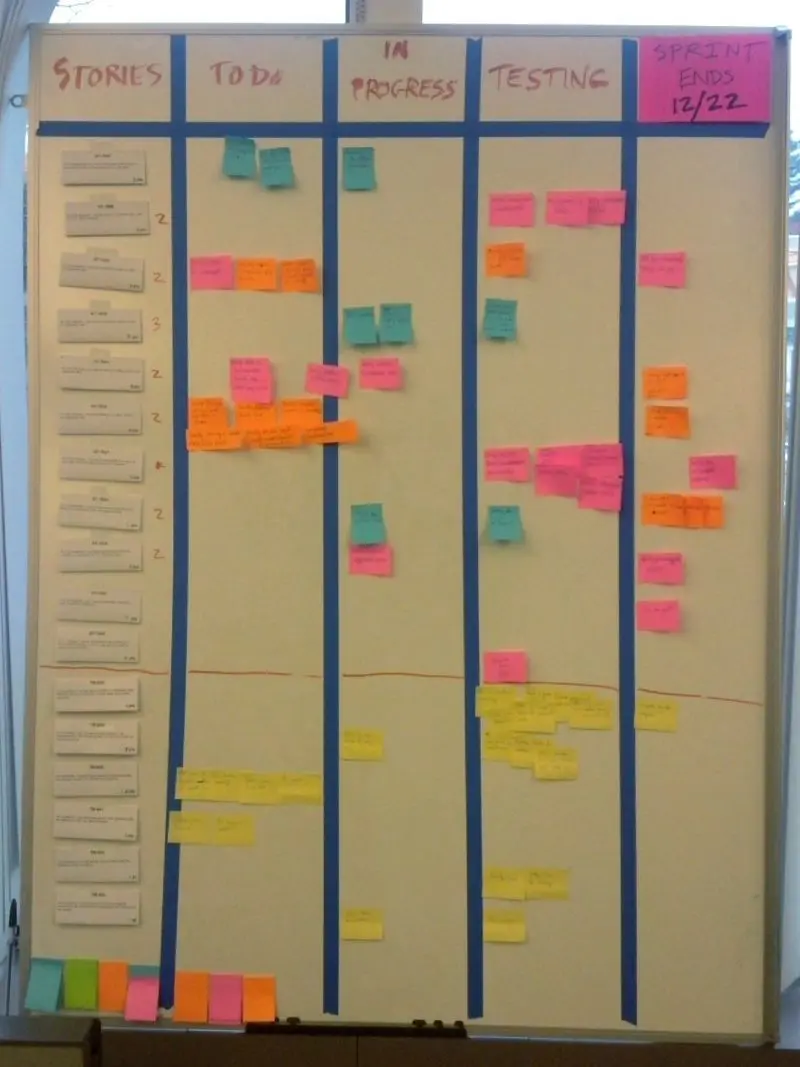Scrum 101: An Introduction to Scrum Project Management
Get to know the basics of this Agile framework

Projects come in an array of shapes and sizes, which is why it only makes sense that there are different ways to manage and execute them. One of these ways is Scrum project management, a method that promotes a smarter way of working so that you can accomplish more. Here’s what you need to know about it.
What is Scrum Project Management?
Scrum is Agile, but Agile is not Scrum. You often hear the terms ‘Scrum’ and ‘Agile’ used together, and because of this, their meanings get a little misconstrued.
The difference between Scrum and Agile:
To clarify, Agile development, which places a large emphasis on collaboration, flexibility, continuous improvement, and high-quality results adhere to the values and principles conveyed in the Agile Manifesto. It uses popular project management frameworks to execute the activity. Scrum is one of those frameworks.

Scrum project management is an Agile framework. This means that it’s a structure used to implement the ideas behind Agile project management. Its aim is to develop, deliver, and sustain complex products through collaboration, accountability, and iterative progress. It also encourages collaborative decision-making and constructive feedback, so that a higher quality product can be delivered efficiently.
A Brief Timeline of Scrum History:
- 1986: Hirotaka Takeuchi and Ikujiro Nonaka introduced the term ‘Scrum’ in a product development context in a Harvard Business Review article, ‘New New Product Development Game’.
- 1990s: Ken Schwaber and Jeff Sutherland, separately, used similar approaches in their companies.
- 1995: Schwaber and Sutherland presented a paper at the Business Object Design and Implementation Workshop, which was a part of the Object-Oriented Programming, Systems, Languages and Applications ’95, in Austin, Texas, of the Scrum that we know of today.
- 2001: Schwaber worked with Mike Beedle to explain the method in the book, ‘Agile Software Development with Scrum’.
- 2009: After co-founding, and leaving, the Scrum Alliance, Schwaber founded Scrum.org which manages the parallel professional Scrum accreditation series.
- 2010: The Scrum Guide is created by Schwaber and Sutherland, a public document, often revised, that defines Scrum.
The Values of Scrum Project Management
Scrum project management is known to be simple to understand, yet tricky to master. But teams who decide to implement this Agile framework can look to uphold the following values to ensure the Scrum pillars of transparency, inspection, and adaptation come to fruition throughout the project activity.
The five values of Scrum are:
- Commitment
- Courage
- Focus
- Openness
- Respect
Who Uses Scrum Project Management?
Although initially created with software development teams in mind, Scrum project management is not exclusively for developers. One of the more popular Agile frameworks, Scrum can benefit teams who have to carry out complex projects across any industry and business. The ideal Scrum team is a group of highly flexible and adaptive individuals who thrive in the context of an iterative and incremental delivery structure, and aren’t afraid to give and receive feedback.

Discover the ultimate project management tool for Scrum.
Sign up for free today!
The Scrum Team
A Scrum project management team consists of three roles, the Product Owner, the Development Team, and the Scrum Master. The roles are self-organizing and cross-functional and designed to maximize flexibility, creativity, and productivity.
Product Owner
The Product Owner is the product expert and the one person who represents the stakeholders and the voice of the customer. They are solely responsible, and accountable, for managing the Product Backlog, with duties that include:
- Clearly expressing Product Backlog items;
- Ordering the items in the Product Backlog to best achieve goals and missions;
- Optimizing the value of the work the Development Team performs;
- Ensuring that the Product Backlog is visible, transparent, and clear to all, and shows what the Scrum Team will work on next; and,
- Ensuring the Development Team understands items in the Product Backlog to the level needed.
The ideal Product Owner must possess empathy, as they often have to understand different perspectives, and have impeccable communication skills, as they have to negotiate with stakeholders and customers, as well as successfully collaborate with the Development Team and the Scrum Master.
Development Team
The Development Team is a group of professionals, such as developers, programmers, or designers who deliver the product and create the Increment (the working product functionality that is presented to the stakeholders at the end of the sprint and could potentially be given to the customer). A successful development team includes the following traits:
- They are self-organizing. No one (not even the Scrum Master) tells the Development Team how to turn Product Backlog into Increments of potentially releasable functionality;
- Development Teams are cross-functional, with all the skills as a team necessary to create a product Increment;
- Scrum recognizes no titles for Development Team members, regardless of the work being performed by the person;
- Scrum recognizes no sub-teams in the Development Team, regardless of domains that need to be addressed like testing, architecture, operations, or business analysis; and,
- Individual Development Team members may have specialized skills and areas of focus, but accountability belongs to the Development Team as a whole.
Scrum Master
Scrum project management is facilitated by the Scrum Master, who is a super-organized servant-leader that ensures the understanding and execution of Scrum is followed. They are responsible for making sure the development team is on track by providing them with necessary resources, and blocking out any distractions that may hinder the development process.
The Scrum Master’s overall responsibility lies in ensuring the team successfully executes Scrum project management, and that everyone involved understands Scrum’s core aim. They do this in various ways that include:
- Leading and coaching the organization in its Scrum adoption;
- Planning Scrum implementations within the organization;
- Helping employees and stakeholders understand and enact Scrum and empirical product development;
- Causing change that increases the productivity of the Scrum Team; and,
- Working with other Scrum Masters to increase the effectiveness of the application of Scrum in the organization.

Now that you know who’s involved in Scrum project management, it’s time to understand how it works.
Scrum Project Management Events
Scrum project management is applied by following a workflow made up of events. The events are time-boxed, meaning they hold a maximum duration time that cannot be exceeded. The aim of this is to reduce wasted time during the development process, as well as allow for critical transparency and inspection to happen. The events are:
Sprint
Sprints are known to be the very essence of Scrum project management. They are time-boxed, iterative, and serve the purpose of accomplishing a goal — usually to create a usable, potentially releasable product or even to move an item from ‘Doing’ to ‘Done’. Not exceeding one calendar month, their time frames — which are commonly two weeks long — are consistent throughout the development process, with a new sprint starting immediately after the conclusion of the previous one.
Sprint Planning
As the name goes, sprint planning is the event that happens at the beginning of every sprint, where the entire Scrum project management team meets to plan the upcoming sprint. Discussions and arrangements are made to answer two main questions:
- What can be achieved at the end of this upcoming Sprint?
- How are we going to achieve this, and what are the actions required to deliver it?
Once these questions are answered, the Scrum project management team will have an idea of the scope of work that is expected throughout the upcoming sprint, and the time allocated for each task. It is also during Sprint Planning that the Sprint Backlog is organized, which is a list of tasks that reflect the work that needs to be completed.
Daily Scrum
The Daily Scrum is a 15-minute time-boxed meeting held at the same time for every day of the sprint. It’s where the Development Team discusses their achievements of the previous day and their expectations for the following one. Although organized by the Scrum Master, the duty of conducting the meeting is solely on the Development Team. The purpose of the Daily Scrum is to synchronize activity, enhance collaboration, and identify any hindrances.
Sprint Review
The Sprint Review is an informal meeting held at the end of every Sprint where the Scrum Team presents their Increment to the stakeholders. During the review, everyone shares feedback and collaborates on what needs to be done in the next Sprint to optimize the value of the product. The review ends with a revised Product Backlog that outlines the items for the next Sprint based on what was collectively discussed and agreed upon.
Sprint Retrospective
The Sprint Retrospective occurs after the Sprint Review and before the next Sprint Planning. It is a meeting where the Scrum Team reflects on the proceedings of the previous Sprint and establishes rooms for improvement in the next Sprint. Although the point of Scrum project management is to enable improvement to happen at any time, the Sprint Retrospective is an opportunity for the team to focus on inspection and adaptation formally.
There are two more activities that, although not core to Scrum project management, occur commonly enough to be worth a mention.
- Backlog refinement: this is the ongoing process of reviewing, and updating if need be, the Product Backlog to ensure the items are organized and prioritized to ensure things go swimmingly.
- Sprint cancellation: only the Product Owner has the power to cancel a Sprint, albeit after discussing it with the rest of the team and/or the stakeholders. Reasons for cancelling a Sprint can be due to things such as the company changing direction, or if external circumstances invalidate the Sprint’s goal.
Scrum Artifacts
Artifacts can be seen as the tools needed to deliver and complete the work. Here are the primary artifacts in Scrum project management:
Product Backlog
Managed by the Product Owner, the Product Backlog is where all the requirements needed for a viable product are listed in order of priority. Something that constantly evolves with the product and the team, the Product Backlog is never complete. It includes all the features, functions, requirements, enhancements, and fixes that authorize any changes to be made to the product in future releases.
Sprint Backlog
The Sprint Backlog lists the tasks and requirements that the team need to accomplish during the next Sprint. It is an asset of the Development Team, which is sometimes accompanied by a Scrum task board. A Scrum task board is used to visualize the progress of the tasks in the current sprint, and any changes that are made, in a ‘To Do, Doing, and Done’ format — similar to Zenkit’s Kanban board feature layout.

User Story
User stories have become a popular form of Product Backlog items. A tool used to explain a software feature from an end-user perspective, they help to picture the type of user of the product and start a discussion about what they want, and the reason(s) for it. A common User Story format that is used is:
As a [role], I want [feature], because [reason].
Product Increment
As briefly mentioned, the Product Increment is the result of all the Product Backlog items accomplished during a Sprint. It is the working product functionality that is presented to the stakeholders at the end of the sprint and is considered a step towards the end goal.
How to Manage a Scrum Project
Like many other project management methods, there are various ways Scrum project management teams can go about managing their project. For smaller, co-located teams, a good low-cost approach is to start off with traditional stationery. Spreadsheets can be used to create and manage things like the Product Backlog, and whiteboards and sticky notes can be used to visualize the Scrum task board.
For Scrum project management teams with members who are dispersed, or for teams who are looking to upgrade their tools, using a web-based project management tool (like Zenkit!) can be a more ideal way to manage the project. The software includes features that enable activity to be centralized, and for cross-team collaboration to occur smoothly. The flexibility to coordinate tasks, and access to progress visibility can enhance team collaboration and can offer a more streamlined delivery.
Final Thoughts
So, there you have it, all the basics you need to know so you can get started on developing your dream Scrum team. Just remember that the overall aim of Scrum project management, what with its values, roles, events, and artifacts, is to offer you a more clever approach to working on a project. With its iterative and incremental development process, your goal to deliver a high-quality product is more likely to be achieved.
When you do decide to get sprinting, don’t forget to let us know how it all goes in our comment section. We’d love to hear about your experiences!
Cheers,
Dinnie and the Zenkit Team
FREE 20 MIN. CONSULTATION WITH A PROJECT MANAGEMENT EXPERT
Wanna see how to simplify your workflow with Zenkit in less than a day?
Book a Live Demo